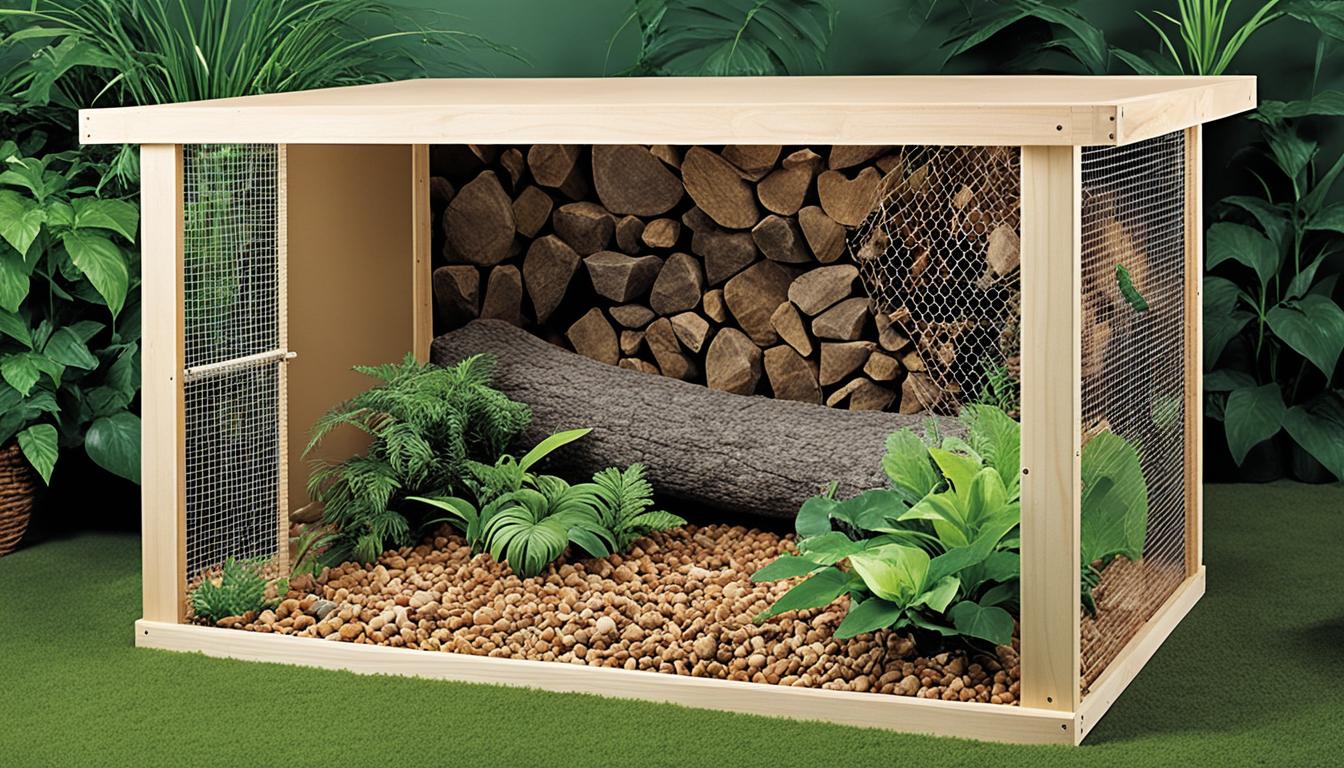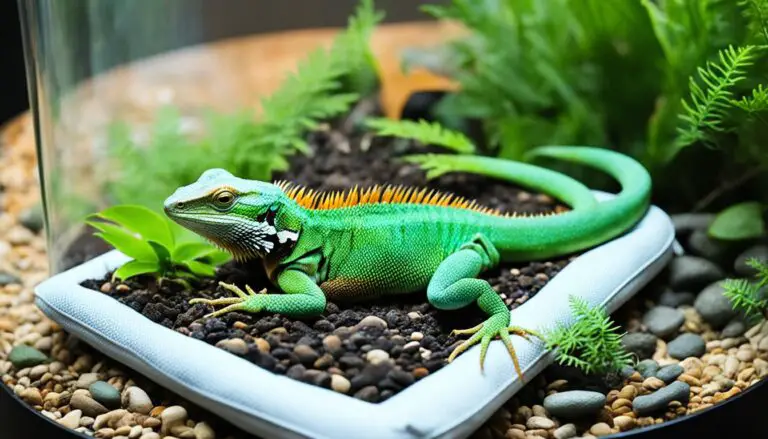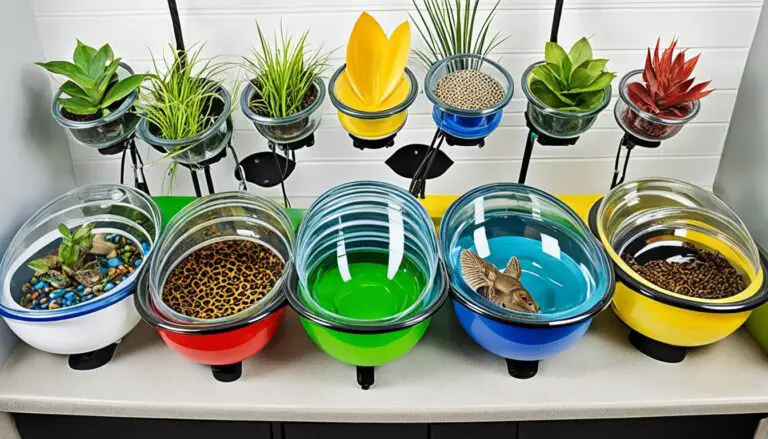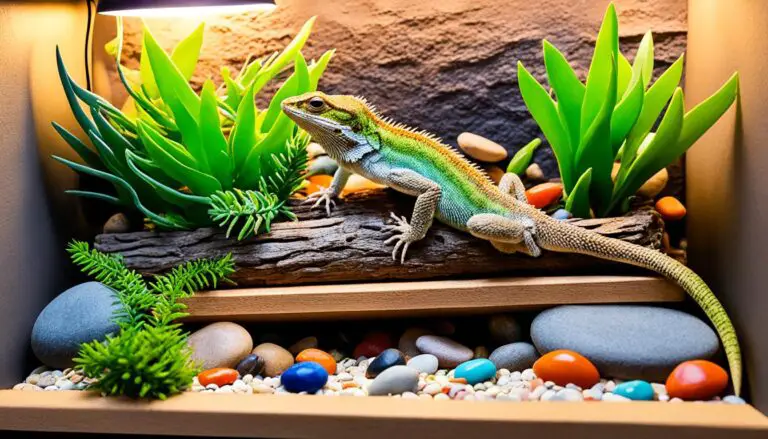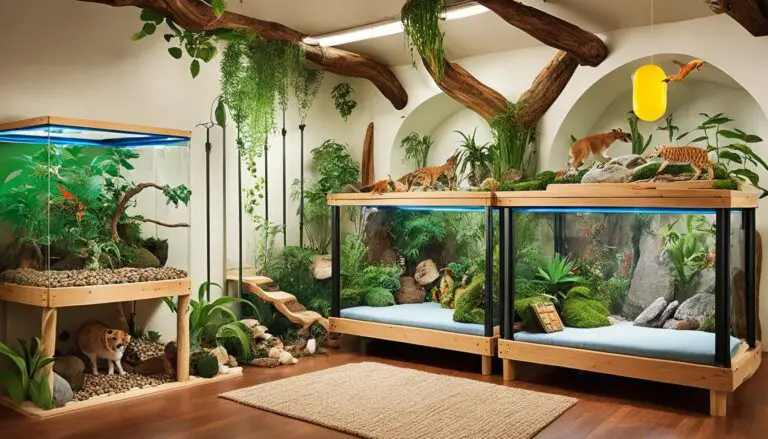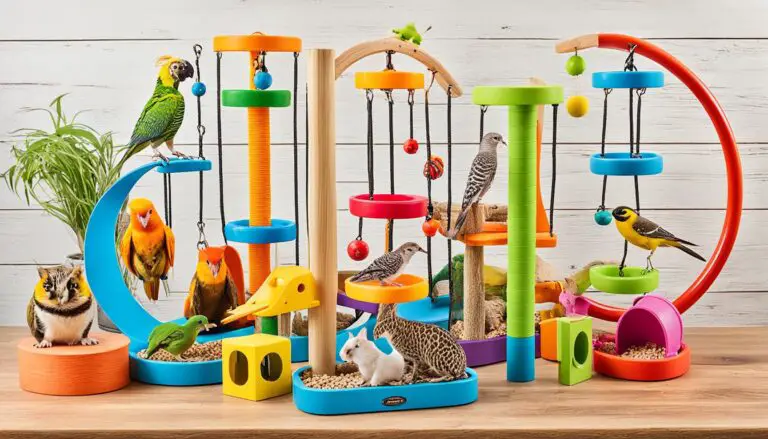Exotic Pet Housing Hides: What to Look For
Exotic pets need special homes and hiding spots to feel good and stay healthy in captivity. The right home for your exotic pet is key to their happiness. Having a space that feels like their natural home reduces stress and makes them happy. This article will talk about what to look for in homes for exotic pets. We want to make sure they have a comfy and fun place to live.
Key Takeaways:
- Researching your pet’s natural habitat is crucial for creating an ideal living space.
- Choosing the right enclosure size, material, and design is essential for your pet’s well-being.
- Proper lighting and temperature are critical components of an exotic pet’s habitat.
- Using substrates that mimic their natural environment helps maintain comfort and humidity levels.
- Offering hiding places and enrichment activities keeps your pet mentally stimulated and engaged.
Research Your Pet’s Natural Habitat
Understanding your exotic pet’s natural habitat is crucial. Each pet has unique needs. Replicating their natural conditions is vital for their well-being.
Research your pet’s native climate, temperature, humidity, and vegetation. This helps you create a habitat that mirrors their natural home.
Think about the climate in their natural habitat. Is it hot and dry or wet and tropical? Knowing this helps you match the perfect temperature and humidity for your pet.
What plants are in your pet’s natural area? This shows what they eat and like. Adding similar vegetation to their space can make them happier.
By researching and recreating your exotic pet’s natural habitat, you make a comfortable space. This promotes their well-being.
Each exotic pet has specific needs. The closer you mimic their natural environment, the better. This means adjusting climate settings, adding proper vegetation, and even rocks and caves. Every detail helps make your pet feel at home.
Benefits of Replicating the Natural Habitat:
- Enhances the physical and mental health of your pet
- Supports natural behaviors and instincts
- Reduces stress and anxiety
- Encourages exploration and physical activity
- Promotes natural feeding and breeding patterns
Proper Research for Optimal Results
Look at reputable sources like scientific articles, books, or experts. Online forums for exotic pet care also offer insights from those who’ve recreated habitats.
By researching your pet’s natural home, you ensure they’re healthy and happy. It enhances their life quality and strengthens your bond as you watch them in a natural-like home.
Choose the Right Enclosure
Choosing the right enclosure is key for your exotic pet’s happiness. It’s their home, offering safety, comfort, and room for natural activities. Think about what size, material, and design would suit your pet best.
Size: The size of the enclosure is super important. Make sure to research what your pet needs. They should have enough space to move, play, and relax. Too small a space can cause stress and health issues. Go for an enclosure that lets your pet live happily.
Material: Picking the right material is crucial for both comfort and safety. Choose sturdy, easy-to-clean, and safe materials. Glass or plastic works great for reptiles, giving clear views and keeping the temperature right. Birds need metal homes to stand up to their beaks and claws. The material should last against daily use.
Design: An enclosure’s design should match what your pet loves doing. Reptiles and some primates need places to climb. Think branches or perches. For pets that burrow, like hamsters or rabbits, choose homes with tunnels or areas for digging. It’s all about making your pet’s home as welcoming as possible.
Every exotic pet is different, so it’s key to know what they need. The right home helps them stay healthy and happy.

Benefits of Choosing the Right Enclosure
- Enhances your pet’s overall well-being.
- Provides enough space for natural behaviors.
- Promotes physical and mental health.
- Ensures comfort and security.
- Easy to clean and maintain.
- Minimizes stress and behavioral issues.
Provide Proper Lighting and Temperature
Creating a comfortable home for your exotic pet is key. Proper lighting and temperature are very important. Find out what your pet needs and make sure they get it.
UVB Lighting for Calcium Metabolism
Many reptiles and amphibians need UVB lighting. It helps them process calcium properly. Without UVB light, they could get sick or have weak bones.
Expert Tip: Make sure the UVB light for your pet is set up right. Change it when needed. Ask a vet about the best UVB level and how long to use it each day.
Temperature Gradient for Health and Digestion
A good temperature range is vital for exotic pets. They can choose warmer or cooler spots as needed. This keeps them happy and healthy.
Heating equipment like ceramic heaters or heat mats can help. Always check the temperature to keep their home comfortable. This supports their eating habits and overall well-being.
Invest in High-Quality Lighting and Heating Equipment
Buying good-quality lighting and heating tools is a must. Choose products made for exotic pets from trusted brands. Cheap options might harm your pet’s health.
Takeaways
- Ensure your exotic pet receives proper UVB lighting for calcium metabolism.
- Provide a temperature gradient within the enclosure to support thermoregulation.
- Use high-quality lighting and heating equipment to create a comfortable and appropriate environment.
| Lamp Type | Recommended for | Bulb Lifespan | Price Range |
|---|---|---|---|
| Mercury Vapor Bulbs | Reptiles, including bearded dragons and turtles | 6-12 months | $20-$50 |
| Fluorescent UVB Bulbs | Various reptiles and amphibians | 6-12 months | $15-$30 |
| Ceramic Heat Emitters | Nocturnal reptiles, snakes, and birds | Up to 10,000 hours | $10-$20 |
Mimic Natural Substrates
It’s important to make the environment like your exotic pet’s natural home. One key part is choosing the right substrates. These substrates provide a cozy walking surface and help keep the humidity perfect.
To match your pet’s specific needs, pick substrates based on their natural environment. By researching, you can create a comfortable and familiar space for them.
For pets needing moist environments, like some reptiles or amphibians, consider moss, coconut fiber, or bark mulch. These choices help hold moisture. They offer a good walking surface and help keep the air just right.
Pets that like it dry might need sand or desert substrates. This copies the dry places some exotic animals call home.
Choosing natural-like substrates makes the environment more real and lets pets do natural things like digging.
Keep substrates clean and change them often. This stops bacteria or bugs from growing. Regular care keeps your pet’s home clean and safe.

Benefits of Mimicking Natural Substrates
Using natural-like substrates has many good points:
- Comfortable Surface: They give pets a comfy place to walk, like their natural homes.
- Maintaining Humidity Levels: Moisture-holding substrates keep the air right for your pet’s health.
- Encouraging Natural Behaviors: The best substrates let pets act naturally, like digging, which is good for them.
Choosing the right substrates and keeping them fresh helps your pet feel at home. This makes them happier and healthier for a long time.
Offer Hiding Places and Enrichment
Keeping exotic pets active and happy is crucial. You can do this by providing toys, climbing places, and spots to hide. These additions make their environment fun. They also keep your pet healthy.
For a better hideout, think about what your pet’s natural home looks like. You might use caves, hollow logs, or special hideouts. These places offer safety and privacy when your pet is stressed.
Toys can stop your pet from getting bored. Pick toys that fit your pet’s needs and mimic natural activities. Think about using puzzle toys or toys that give treats. They make your pet think and stay active.
Climbing areas are key for pets that like to climb. These can be simple branches or big climbing walls. They give your pet a chance to move around and explore.
When adding new items, do it slowly. This makes sure your pet doesn’t get upset. Watch how they act with the new things. Then, make changes if needed to keep them happy and interested.
Maintain a Clean and Healthy Habitat
Keeping your exotic pet healthy starts with regular habitat maintenance. By cleaning, disinfecting, and managing waste, you create a safe space. This stops harmful bacteria from growing.
Here are important tips for keeping your exotic pet’s home in top shape:
Cleaning and Disinfecting
Cleanliness is key for a healthy pet environment. Use safe cleaners to remove dirt and stains from the enclosure. Focus on areas like litter boxes or bedding, where waste gathers.
It’s crucial to disinfect to kill harmful germs. Choose a disinfectant made for exotic pets and follow the directions. Make sure the habitat is rinsed well and dry to protect your pet.
Waste Management
Keeping the habitat clean means regularly taking out waste. This includes poop, pee, leftover food, and dirty bedding. Dispose of it properly and try to use eco-friendly bags.
If your pet has a litter box, keep it clean. Change the litter often to stop smells and germs. This keeps the home neat and lowers disease risk.
Cleaning Frequency
How often to clean depends on the pet. Some need daily cleaning, while others can wait a week. Watch your pet and their home to decide on a cleaning schedule.
Also, regularly wash and replace toys and other items. Follow cleaning directions and avoid toxic products to keep your pet safe.
Monitoring and Prevention
Watch for signs of sickness or pests in your pet’s home. If something seems off, act fast. Quick action can keep small problems from getting big.
Keeping the habitat clean and seeing the vet often are good ways to prevent illness. Follow expert advice to help your exotic pet live a long, happy life.
| Exotic Pet Habitat Maintenance Checklist |
|---|
| Establish a cleaning routine that suits your pet’s needs. |
| Use pet-safe cleaning products to clean and disinfect the habitat. |
| Thoroughly rinse and dry the habitat after disinfection. |
| Regularly remove waste, including feces, urine, and uneaten food. |
| Clean and replace litter or substrate in waste elimination areas. |
| Monitor your pet’s habitat for signs of illness or issues. |
| Regularly clean and replace toys, enrichment items, and accessories. |
| Seek professional advice and follow preventive measures for your pet’s health. |
Seek Professional Advice
Creating a home for your exotic pet can be tough, especially for new pet owners. To make sure your special friend is happy and healthy, getting advice from a vet who knows about exotic animals is key.
A vet with the right knowledge can help you with your pet’s home, lights, and warmth. They can guide you on the best enclosure for your pet. This makes sure your pet has room to play and live well. Vets can also tell you about the best lights to make your pet feel at home.
When you talk to a vet, you learn about keeping the right temperature for your pet. Exotic pets need special warmth, and a vet can show you how to keep it just right. This helps your pet stay healthy and happy.
FAQ
What should I look for in exotic pet housing hides?
Why is it important to research my pet’s natural habitat?
How do I choose the right enclosure for my exotic pet?
What are the important aspects of providing proper lighting and temperature for my exotic pet?
How do I mimic natural substrates for my exotic pet?
Why should I offer hiding places and enrichment for my exotic pet?
How important is maintaining a clean and healthy habitat for my exotic pet?
Should I seek professional advice for my exotic pet?
Source Links
- https://vethotspot.com/2023/08/24/creating-an-ideal-habitat-for-your-exotic-pet/
- https://blog.rentconfident.com/1897/apartment-hunting-for-exotic-pet-owners/
- https://www.reddit.com/r/snakes/comments/9gjqo7/found_a_way_to_keep_my_baby_after_moving_to_an/
Peter Stones is the founder of Exotic Pets Place, the leading online resource for exotic pet care information.
With over 10 years of hands-on exotic pet ownership experience, he is deeply passionate about sharing his expertise to help others properly care for their unusual pets.
When he's not writing extensively researched articles or connecting with fellow exotic pet enthusiasts worldwide, you can find Peter at home tending to his own beloved menagerie of exotic animals.

